Orbital diagram

| Discovery [1] [2] | |
|---|---|
| Discovered by | N. Danzl |
| Discovery site | Spacewatch Kitt Peak National Obs. |
| Discovery date | 19 September 1995 |
| Designations | |
| (24835) 1995 SM55 | |
| 1995 SM55 | |
| TNO [1] · Haumea [3] · cubewano [4] [5] Scat-Ext [6] · distant [2] | |
| Orbital characteristics [1] | |
| Epoch 4 September 2017 (JD 2458000.5) | |
| Uncertainty parameter 3 | |
| Observation arc | 34.29 yr (12,523 days) |
| Aphelion | 45.870 AU |
| Perihelion | 37.386 AU |
| 41.628 AU | |
| Eccentricity | 0.1019 |
| 268.59 yr (98,101 days) | |
| 329.45° | |
| 0° 0m 13.32s / day | |
| Inclination | 27.096° |
| 21.109° | |
| ≈ 7 June 2040 [7] ±5 days | |
| 72.600° | |
| Physical characteristics | |
Mean diameter | 173 km(estimate) [3] 519.43 km(derived) [8] 610 km(Haumea-derived) [9] 701 km [4] 704 km(upper limit) [10] [11] |
| 8.08±0.02 h [12] 8.08±0.03 h [13] | |
| 0.7 (Haumea-derived) [3] 0.040 [4] 0.067 (at least) [10] 0.10 (assumed) [8] | |
| BBb (suspected) [14] · C [8] (Neutral) B–V = 0.65 [8] V−R = 0.37 [8] V−I = 0.710 [8] | |
| 4.30±0.02(R) [15] 4.352±0.040(R) [16] 4.490±0.030 [17] 4.54 [8] [18] ·4.6 [1] ·4.9 [3] | |
(24835) 1995 SM55 (provisional designation 1995 SM55) is a trans-Neptunian object and member of the Haumea family that resides in the Kuiper belt, located in the outermost region of the Solar System. It was discovered on 19 September 1995, by American astronomer Nichole Danzl of the Spacewatch program at Kitt Peak National Observatory near Tucson, Arizona, in the United States. [2] It measures approximately 200 kilometers in diameter and was the second-brightest known object in the Kuiper belt, after Pluto, until 1996 TO66 was discovered.
1995 SM55 is a member of the Haumea family. [3] It has the highest collisional velocity, a δv of 123.3 m/s, of all confirmed members. [19] Based on their common pattern of IR water-ice absorptions, neutral visible spectrum [20] and the clustering of their orbital elements, the other KBOs 1996 TO66 , 2002 TX300 , 2003 OP32 and 2005 RR43 all appear to be collisional fragments broken off of the dwarf planet Haumea.
As of 2018, this minor planet has not been named by the Minor Planet Center. [2]


A classical Kuiper belt object, also called a cubewano ( "QB1-o"), is a low-eccentricity Kuiper belt object (KBO) that orbits beyond Neptune and is not controlled by an orbital resonance with Neptune. Cubewanos have orbits with semi-major axes in the 40–50 AU range and, unlike Pluto, do not cross Neptune's orbit. That is, they have low-eccentricity and sometimes low-inclination orbits like the classical planets.

A trans-Neptunian object (TNO), also written transneptunian object, is any minor planet in the Solar System that orbits the Sun at a greater average distance than Neptune, which has an orbital semi-major axis of 30.1 astronomical units (au).
5145 Pholus is an eccentric centaur in the outer Solar System, approximately 180 kilometers in diameter, that crosses the orbit of both Saturn and Neptune. It was discovered on 9 January 1992 by American astronomer David Rabinowitz (uncredited) of UA's Spacewatch survey at the Kitt Peak National Observatory in Arizona, United States. The very reddish object has an elongated shape and a rotation period of 9.98 hours. It was named after the centaur Pholus from Greek mythology.
8405 Asbolus is a centaur orbiting in the outer Solar System between the orbits of Jupiter and Neptune. It was discovered on 5 April 1995, by James Scotti and Robert Jedicke of Spacewatch (credited) at Kitt Peak Observatory in Arizona, United States. It is named after Asbolus, a centaur in Greek mythology and measures approximately 80 kilometers in diameter.
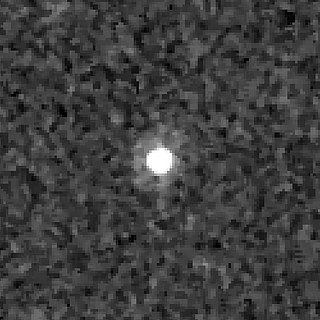
(19308) 1996 TO66 (provisional designation 1996 TO66) is a trans-Neptunian object that was discovered in 1996 by Chadwick Trujillo, David Jewitt and Jane Luu. Until 20000 Varuna was discovered, it was the second-largest known object in the Kuiper belt, after Pluto.

(55565) 2002 AW197 (provisional designation 2002 AW197) is a classical, non-resonant trans-Neptunian object from the Kuiper belt in the outermost region of the Solar System, also known as a cubewano. With a likely diameter of at least 700 kilometers (430 miles), it is approximately tied with 2002 MS4 and 2013 FY27 (to within measurement uncertainties) as the largest unnamed object in the Solar System. It was discovered at Palomar Observatory in 2002.
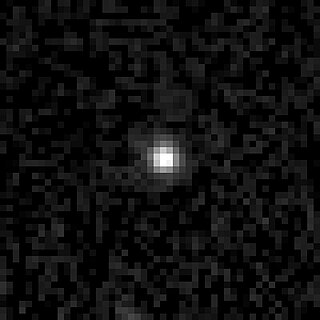
10199 Chariklo is the largest confirmed centaur. It orbits the Sun between Saturn and Uranus, grazing the orbit of Uranus. On 26 March 2014, astronomers announced the discovery of two rings around Chariklo by observing a stellar occultation, making it the first minor planet known to have rings.
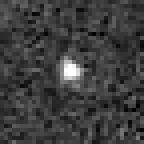
10370 Hylonome (; prov. designation: 1995 DW2) is a minor planet orbiting in the outer Solar System. The dark and icy body belongs to the class of centaurs and measures approximately 72 kilometers (45 miles) in diameter. It was discovered on 27 February 1995, by English astronomer David C. Jewitt and Vietnamese American astronomer Jane Luu at the U.S. Mauna Kea Observatory in Hawaii, and later named after the mythological creature Hylonome.

(55636) 2002 TX300 is a bright Kuiper belt object in the outer Solar System estimated to be about 286 kilometres (178 mi) in diameter. It is a large member of the Haumea family that was discovered on 15 October 2002 by the Near-Earth Asteroid Tracking (NEAT) program.

(84922) 2003 VS2 is a trans-Neptunian object discovered by the Near Earth Asteroid Tracking program on 14 November 2003. Like Pluto, it is in a 2:3 orbital resonance with Neptune and is thus a plutino. Analysis of light-curve suggests that it is not a dwarf planet.
(79983) 1999 DF9 (provisional designation 1999 DF9) is a trans-Neptunian object of the Kuiper belt, classified as a non-resonant cubewano, that measures approximately 270 kilometers in diameter.

(120178) 2003 OP32, also written as (120178) 2003 OP32, is a trans-Neptunian object (TNO) that resides in the Kuiper belt. It was discovered on July 26, 2003 by Michael E. Brown, Chad Trujillo and David L. Rabinowitz at Palomar Mountain in California.

(145453) 2005 RR43 (provisional designation 2005 RR43) is a trans-Neptunian object (TNO) estimated to be about 250 km in diameter. It was discovered on 9 September 2005 by Andrew Becker, Andrew Puckett and Jeremy Kubica at Apache Point Observatory in Sunspot, New Mexico.
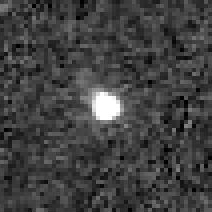
(40314) 1999 KR16 is a trans-Neptunian object on an eccentric orbit in the outermost region of the Solar System, approximately 254 kilometers (158 miles) in diameter. It was discovered on 16 May 1999, by French astronomer Audrey Delsanti and Oliver Hainaut at ESO's La Silla Observatory in northern Chile. The very reddish object is a dwarf planet candidate and has a rotation period of 11.7 hours.

32532 Thereus, provisional designation: 2001 PT13, is a centaur from the outer Solar System, approximately 80 kilometers (50 miles) in diameter. It was discovered on 9 August 2001, by astronomers of the Near-Earth Asteroid Tracking program at the Palomar Observatory in California, United States. This minor planet was named for the phrase thēreios bia 'beastly strength', used to describe centaurs in Greek mythology.
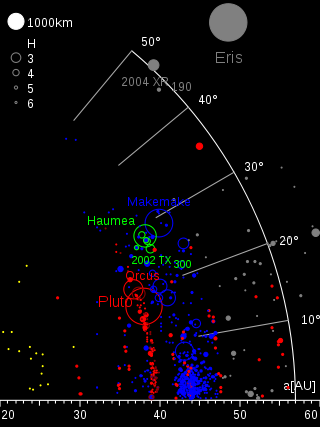
The Haumea or Haumean family is the only identified trans-Neptunian collisional family; that is, the only group of trans-Neptunian objects (TNOs) with similar orbital parameters and spectra that suggest they originated in the disruptive impact of a progenitor body. Calculations indicate that it is probably the only trans-Neptunian collisional family. Members are known as Haumeids.
(55638) 2002 VE95 (provisional designation 2002 VE95) is a trans-Neptunian object from the outermost region of the Solar System. It was discovered on 14 November 2002, by astronomers with the Near-Earth Asteroid Tracking program at the Palomar Observatory in California, United States. This resonant trans-Neptunian object is a member of the plutino population, locked in a 2:3 resonance with Neptune. The object is likely of primordial origin with a heterogeneous surface and a notably reddish color (RR) attributed to the presence of methanol and tholins. It has a poorly defined rotation period of 6.8 hours and measures approximately 250 kilometers (160 miles) in diameter, too small to be a dwarf planet candidate. As of 2021, it has not yet been named.
(469306) 1999 CD158 (provisional designation 1999 CD158) is a trans-Neptunian object from the circumstellar disc of the Kuiper belt, located in the outermost region of the Solar System. The relatively bright hot classical Kuiper belt object measures approximately 310 kilometers (190 miles) in diameter. It was discovered on 10 February 1999, by American astronomers Jane Luu, David Jewitt and Chad Trujillo at Mauna Kea Observatories on the Big Island of Hawaii, United States.

(82158) 2001 FP185 (provisional designation 2001 FP185) is a highly eccentric trans-Neptunian object from the scattered disc in the outermost part of the Solar System, approximately 330 kilometers in diameter. It was discovered on 26 March 2001, by American astronomer Marc Buie at Kitt Peak National Observatory in Arizona, United States.

(416400) 2003 UZ117 (provisional designation 2003 UZ117) is a trans-Neptunian object and suspected member of the Haumea family, located in the Kuiper belt in the outermost region of the Solar System. It was discovered on 24 October 2003, by astronomers of the Spacewatch survey project at Kitt Peak Observatory, Arizona. The object may also be a non-resonant cubewano.